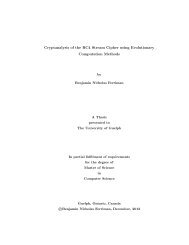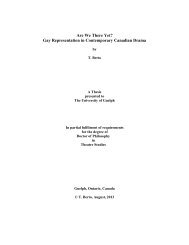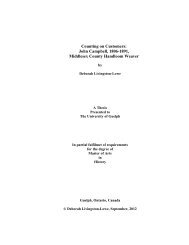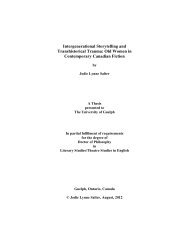THESIS - ROC CH ... - FINAL - resubmission.pdf - University of Guelph
THESIS - ROC CH ... - FINAL - resubmission.pdf - University of Guelph
THESIS - ROC CH ... - FINAL - resubmission.pdf - University of Guelph
Create successful ePaper yourself
Turn your PDF publications into a flip-book with our unique Google optimized e-Paper software.
clumps could not be detected. The observed fragments may be caused by poor dispersion, or<br />
conditions promoting cellulose-cellulose interactions.<br />
Enhanced dispersion <strong>of</strong> the fibers may be addressed by utilizing a recirculating<br />
compounder at elevated temperatures. By unfolding the protein at higher temperatures, protein<br />
chain mobility would be increased which could allow for better flow <strong>of</strong> cellulose fibers throughout<br />
the SPI matrix. With impeded movement through the SPI matrix, cellulose fibers could<br />
accumulate against the barrel walls where higher frictional forces can be experienced.<br />
Aggregate formation via cellulose-cellulose interactions may be promoted during aging<br />
or inside the extruder. When suspended cellulose fibers are mixed into the SPI powder for<br />
aging, moisture is driven away from the fibers by the dry SPI powder. This partial drying could<br />
possibly encourage fibers in close proximity to interact with each other forming semi-<br />
aggregates. Unless these fibers are subject to an environment that would allow them to break<br />
apart, these semi-attached fibers could be sustained and further tangled through the extruder.<br />
Within the extruder, the self-aggregation <strong>of</strong> cellulose fibers may be promoted by shear,<br />
pressure, or the exposure <strong>of</strong> embedded hydrophobic groups. As reported in Section 5.4.1,<br />
preliminary trials <strong>of</strong> applying ultrasonic treatment aggregated the extracted soy fiber<br />
suspensions. Shear and pressure against two surfaces was also witnessed to yield aggregated<br />
clumps from SMF suspensions. As the blended melt flow along screw flights, high shear and<br />
pressure could be experienced against the extruder barrel which could induce the aggregation<br />
<strong>of</strong> cellulose fractions into larger fragments. This would explain as to why the majority <strong>of</strong> these<br />
cellulose rich domains were found on the outskirts <strong>of</strong> the melt against the barrel and screw<br />
surfaces. Moreover, during the unfolding process, increased hydrophobic groups from within the<br />
protein structures are revealed. This could conceivably promote the self-association <strong>of</strong> cellulose<br />
fibers which are highly hydrophilic. However since both filler and matrix are predominately<br />
hydrophilic, the hindrance <strong>of</strong> hydrophobic groups should be <strong>of</strong> minimal consequence.<br />
70

















